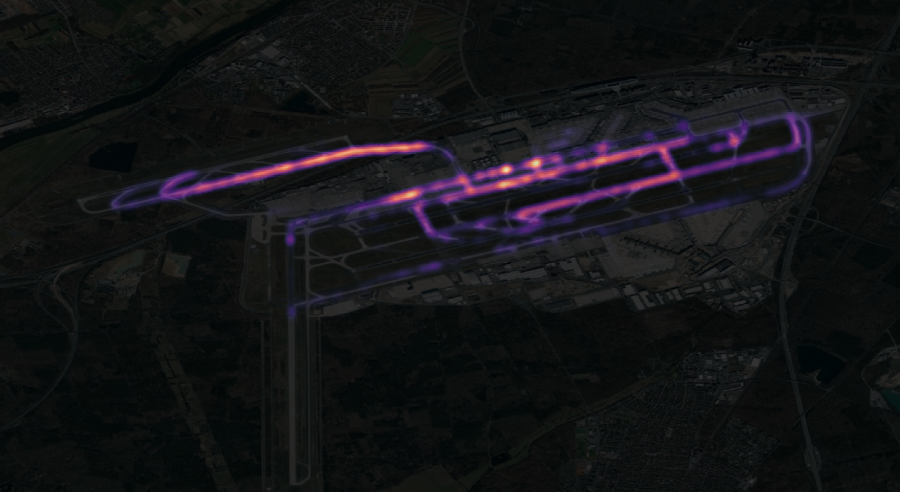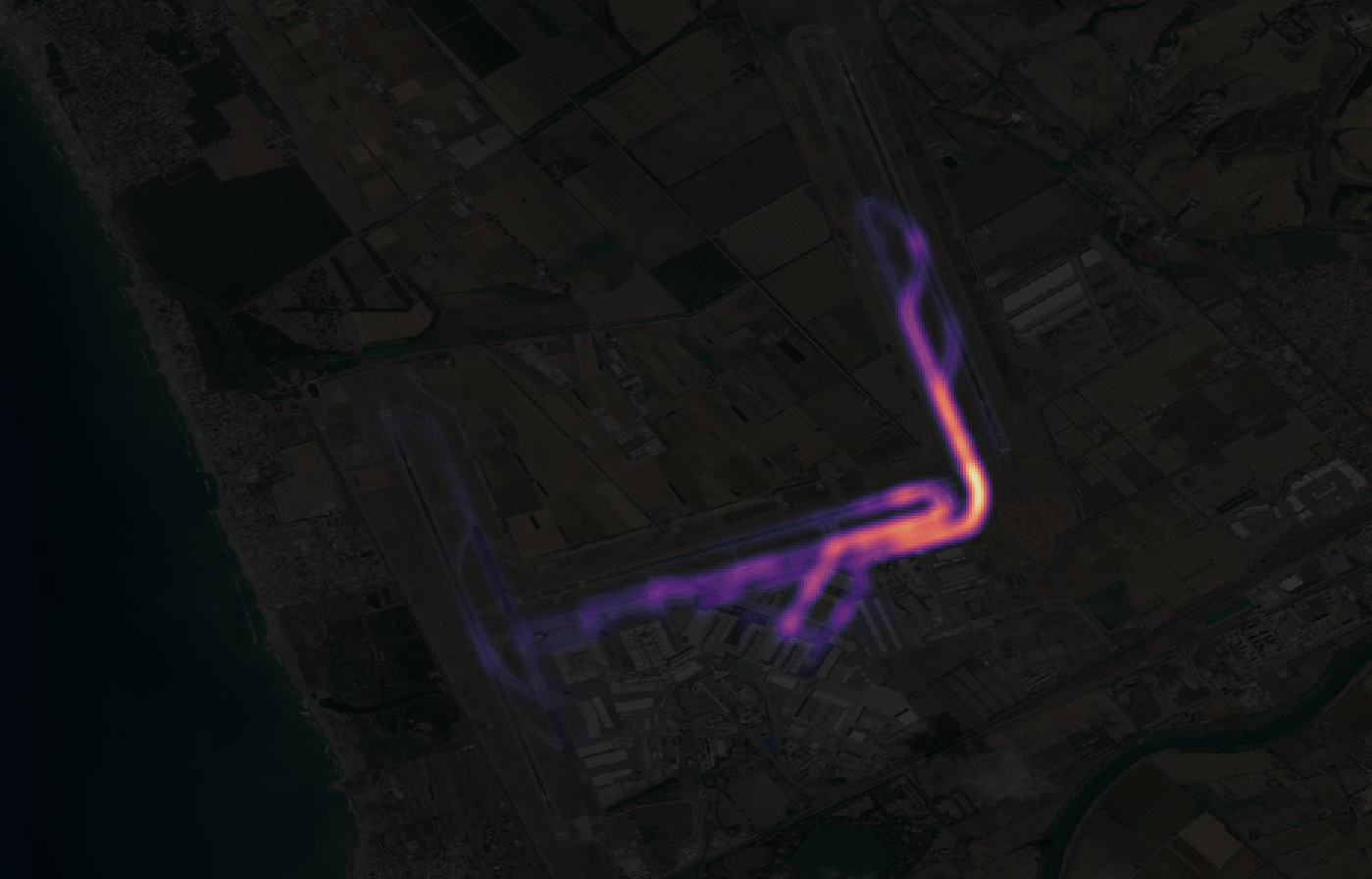VIENNA, VA / ACCESSWIRE / December 12, 2023 / The aviation sector is rapidly approaching uncertain skies ahead. Many industries associated with carbon emissions are actively transitioning to electric alternatives to reach their sustainability goals. Unfortunately, the aviation industry faces unique challenges due to the specific demands inherent in air travel.
 Heatmap of Spire data showing taxiing at Frankfurt Airport
Heatmap of Spire data showing taxiing at Frankfurt Airport
According to Spire Global's (NYSE: SPIR) General Manager of Aviation, Philip Plantholt, for the aviation industry, "there's no good path to short-term sustainability; with other industries getting electrified and going green, aviation will become a bigger contributor to emissions."
When considering fuel consumption in the aviation industry, we typically only think of airborne aircraft. Apart from being the most frustrating segment of travel - stuck in airplane gridlock on the tarmac - taxiing can take up 30% of the total flight's time and can account for 10% of a plane's fuel consumption.
 Spire data showing taxiing pinch points and traffic at Leonardo da Vinci-Fiumicino Airport in Rome
Spire data showing taxiing pinch points and traffic at Leonardo da Vinci-Fiumicino Airport in Rome
This is also a major contributor to localized pollution - a key focus of environmental protection laws around the world.
The Council of the European Union has adopted CORSIA, the Carbon Offsetting and Reduction Scheme for International Aviation. CORSIA is a global scheme aimed at offsetting emissions in international aviation. It was adopted by the International Civil Aviation Organisation (ICAO) in 2018 and the EU conducted a pilot phase from January 2021 to 2023. As CORSIA begins its first (post-pilot) phase, its influence on the aviation industry's efforts to curtail its carbon footprint will be directed towards addressing current inefficiencies
Why does this matter for planes taxiing? Airplane emissions produced between ground level and 3,000 feet have a direct impact on local air quality, emitting C02, oxides of sulfur and nitrogen, soot and metal particles, as well as water vapor.
This low-level fuel consumption is significant for several reasons. Hence, why it is a primary target of what CORSIA, and many other environmental acts. The environmental costs of inefficiencies in flight and ground operations need to be tracked, traced, and eliminated. Not dealing with those inefficiencies will be costly to airlines and passengers.
 A heatmap of taxiing traffic at Gatwick Airport in London
A heatmap of taxiing traffic at Gatwick Airport in London
Airplane engines are designed for pushing aircraft while airborne - and they're incredibly efficient at that - unfortunately they're less efficient at ground level while taxiing. Engines need time to warm up, and traffic while taxiing at airports increase fuel consumption through constant starts and stops. In a 15-minute taxi from gate to runway, a Boeing 747 can burn up to a metric ton of fuel - that's around US$700.
The Environmental and Energy Study Institute (EESG) has found that 90 percent of aircraft emissions occur above 3,000 feet. That leaves a remaining 10 percent of emissions from every flight at the ground level. That percentage can grow for short-haul flights where taxiing may make up a larger portion of the overall trip duration.
Since 2014, Frankfurt airport has used tow vehicles from a company called TaxiBot for Lufthansa's 737 fleet to reduce fuel consumption. The tow vehicles are controlled by the pilot between the gate and the runway and allow the engines to remain idle. For Frankfurt, this has saved 11,000 metric tons of fuel per year.
A competitor company is WheelTug, which is developing a motor operating directly on modified aircraft. The system works off the aircraft's auxiliary power to drive the nose wheels for taxiing.
Some airlines with the busiest flight routes and numerous aircraft are using the least efficient planes. The relatively new Airbus A320, a narrow body aircraft, consumes 13 pounds of fuel per minute while taxiing - or 0.2 pounds of fuel per second. For a new aircraft, this is considered a poor emissions rating, especially for localized pollution standards set by the European Environmental Agency for the EU and the EPA in the United States.
Beyond carbon dioxide, airline taxiing is also a source of local Green House Gas emissions.
If we want to look at the problems of taxiing pollution, we have to look at what creates the traffic congestion at airports. An increase in travelers is an obvious first pain point, since the pandemic has led airlines to use their full fleets to cover the boost in traffic.
On top of travelers, air traffic controllers need better tools and data to effectively manage increasingly crowded airspace. This can delay flights when traffic is heavier than air traffic control (ATC) on the ground can handle safely - this is one issue that Spire's work on the EURIALO project aims to solve. By providing better tools to ATC for monitoring flight operations from space, busy skies can be managed across a global team.
Finding and improving efficiencies relies on better operational data. Ops-critical data means that there could be costs or damage if information is unavailable, defective, or wrong. Spire is ahead of the crowd in ensuring that the right information is collected in the most efficient way.
One goal for Spire's EURIALO project is helping to optimize ops-critical information so airlines run more efficiently.
"By helping airlines' operational control have better understanding and real-time awareness of how current taxiing and holding times are predicted in the near-term will greatly help to better optimize controls in case of disruption," says Plantholt.
"Only a handful of space companies have a similar heritage in spacebased aircraft tracking. The cost for a global constellation is in the hundreds of millions over a multi-year service lifetime," says Plantholt.
Spire's global constellation is already in place and active in ADS-B data collection.
To cover traffic increases, some airlines are using slightly older equipment that may run less efficiently. The increase in active travelers especially after the pandemic - and cargo flights - means the airspace above is busier than ever.
However, delays and fuel inefficiencies don't only occur on the ground. They also affect arrival times. Flights circling in holding patterns above an airport waiting to land also impact local air quality. These small inefficiencies will have severe costs to the aviation industry when CORSIA is enacted.
Ironing out these inefficiencies is immediate and mandatory for airlines to survive. Projects like Spire's EURIALO and existing ADS-B tracking already provide the foundation for building solutions that will contribute to a greener aviation industry.
Contact:
Ben Hackman
This email address is being protected from spambots. You need JavaScript enabled to view it.
| Last Trade: | US$8.97 |
| Daily Change: | -0.08 -0.88 |
| Daily Volume: | 323,386 |
| Market Cap: | US$293.500M |
December 02, 2025 November 28, 2025 November 18, 2025 November 03, 2025 | |
COPYRIGHT ©2025 GREEN STOCK NEWS